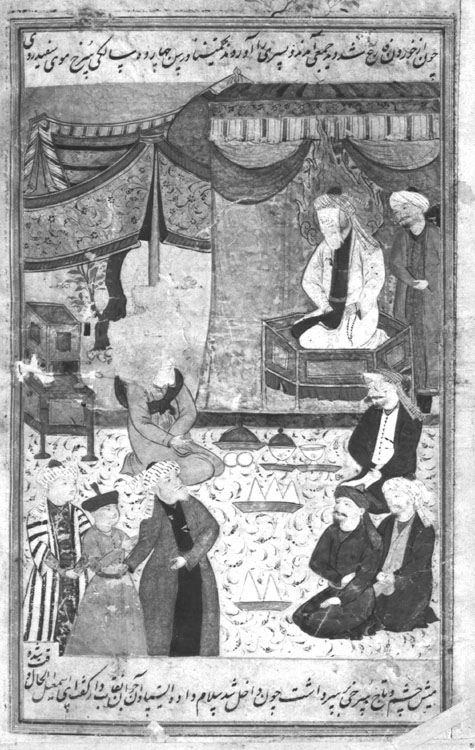The Young Esmāʿil Before the 12th Imam
Date of this event: 906/1500
Following the death of his older brother Sultan ʿAli Pādešāh in 898/1492-93 or 900/1494-95, Esmāʿil, then about seven and one half years of age, and accompanied by 200 retainers, took refuge in the province of Gilān, first in Rašt, then in Lāhijān. There he remained some five or six years awaiting a sign from the unforeseen world. In 906/1500-01 hostilities broke out between the various ʿĀq Qoyunlu factions, and Esmāʿil, not wanting to stay in Gilān any longer, and according to Eskandar Monši, inspired by divine revelation, decided to leave Gilān and make his bid for power.
The text adjoining the painting relates the following account. When the imam had finished eating, a group arrived with a boy in his fourteenth year. His hair was red, his face white, his eyes light brown, and he wore a red tāj on his head. When the boy came in, he said salam and stood there. That man, with the veil over his face responded, "Esmāʿil, now is the time!". The youth in the lower left with the red tāj is obviously Esmāʿil, and being in his fourteenth year would place the date at 906/1500-01. The painting therefore depicts that Divine revelation referred to by Monši, given to Esmāʿil through the Twelfth Imam, saying "now is the time".
The dominant figure, in the upper right, is a personage dressed in a long robe and seated on an elevated hexagonal throne. He wears a turban, has prayer beads in his hand, his head is surrounded by a flaming halo indicative of a prophet, and a white veil masks his face. Written on the veil in small characters are the words yā ṣāḥeb al-zamān, an invocation normally addressed to the Twelfth Imam. The imam is seated before the opening of a tent, and the continuation of the encampment extends to the left frame of the picture. In the lower left is a group of three individuals - two men dressed in long robes and turbans, apparently religious figures, who flank the young Esmāʿil, dressed in a long coat belted at the waist, and a distinctive qezelbāš tāj with kolāh. They are apparently conversing with the imam. Five other personage appear in the painting. Three, apparently religious dignitaries with long robes and turbans, are seated in the right foreground, their hands in their laps and facing the group in the lower left, Another figure, similarly attired, but whose head has been obliterated by damage to the painting, is seated before the imam on the left. And lastly, a fifth individual much like the others, stands behind the imam in the upper right.
Painting: 16.7 x 12.2 cm. One line of text above and below the painting. Frame encloses painting and text; a tree protrudes beyond the frame into the top margin. Painting damaged in several places: a hole 2cm. in diameter in the middle obliterates the face of one dignitary; a smaller ragged hole is further to the left adjoining the frame; the lower right corner of the frame is missing. Other smaller areas of damage and wear are also apparent. No signs of retouching. The painting is not signed.
Painting references:
Unpublished.
Text references:
See Muntaẓer-Ṣāḥeb_1970, p.41-42 for this event in the History of Shah Esmāʿil
Robert Eng
Last updated: November 10, 2010
